Community Impact of Public Processions
The study examined the community impact of public processions, with a particular focus on processions which were perceived to be 'problematic'. The research involved a multi-method approach and included qualitative and quantitative data collection. Although the research considered a wide range of processions (including community and political), its particular focus was on Loyalist and Irish Republican processions.
Annex C: Further Analysis Of Pre And Post Procession Survey Samples
A series of additional bivariate and other statistical analyses were conducted on the pre and post procession survey samples to explore possible relationships and associations between different responses. It needs to be borne in mind, given that the survey responses were largely generated via non-random convenience sampling, that these tests are used to explore indicative associations and relationships, and not to make definitive generalisations about specific areas of populations. In particular p values reported in this appendix are presented to give the reader an idea of the strength of the association between variables; they again should not be interpreted as signifying that findings are generalizable to broader populations beyond the survey samples themselves.
Pre-procession
Respondents of different religions were not evenly distributed across the sites in the sample - for example, around two thirds of Coatbridge respondents who indicated a religious affiliation were Catholic (29 people), compared with less than a third of Parkhead (24 people) and just over a third of Govan respondents (16 people). To investigate whether it was area or religion that had the strongest association with opinions in this sample, two binary logistic regression models were estimated that predicted, respectively, the probability of holding negative views of Loyalist and Irish Republican events. Location and religion were included as covariates.
Table AC.1: Binary logistic regression models predicting negative views of processions
| Odds ratios |
||
|---|---|---|
|
|
Loyalist |
Irish Republican |
| Area (ref: Coatbridge) |
||
| Parkhead |
0.33* |
0.20** |
| Govan |
0.45 |
0.13** |
| Religious affiliation (ref: Catholic) |
||
| Protestant |
0.09** |
0.87 |
| Other or none |
0.47+ |
1.20 |
| N |
161 |
144 |
| + p<.1, * p<.05, ** p<.01 |
||
These indicate that both area and religion could be important. Holding religion constant, Coatbridge respondents were more negative about Loyalist and Irish republican events than others; holding area constant, Catholics in the sample were more likely to be negative about Loyalist parades, but there was no independent association between religion and views of Irish republican events.
Area and religion were not the only respondent characteristics associated with views of processions. Female respondents were more likely to be negative about both Loyalist and Irish republican events. Three fifths of female respondents felt negative about Loyalist processions, compared with two fifths of male respondents (51 and 35 people, respectively).[68] Similarly, less than half of male respondents (35 people) were negative about Irish Republican events, compared with nearly two thirds of female respondents (46 people).[69]
5.11 Respondent's views also varied according to age. Figure AC.1 plots the association between age and negative views of Loyalist processions.[70] The figure shows that respondent's views first tended to become more negative as they got older, reaching a peak at the early 40s, then began to become less negative with increasing age. There was less association between age and views of Irish Republican events.
Figure AC.1: Association between age and negative views of Loyalist processions
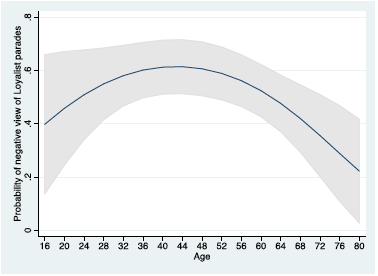
5.12 Survey respondents' views of processions were also associated with the perceptions of community characteristics and racial/ethnic prejudice in Scottish society. Notably, perceptions or experiences of social cohesion[71] were associated with respondent views of Loyalist parades - those who experienced less social cohesion tended to be more negative (see Figures AC.2 and AC.3).[72] Interestingly, this generally negative association (i.e. people who perceived more social cohesion tended to be less negative about Loyalist processions) was found among Protestants, Catholics and those with other or no religion. By contrast, the association between perceptions of social cohesion and negative views of Irish Republican events was weaker (see Figure AC.3).
Figure AC.2: Association between perceptions of social cohesion and negative views of Loyalist processions
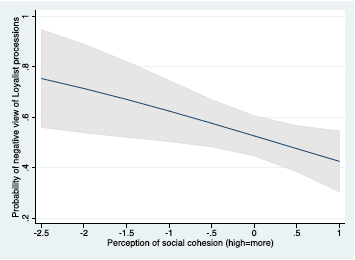
Figure AC.3: Association between perceptions of social cohesion and negative views of Irish Republican processions
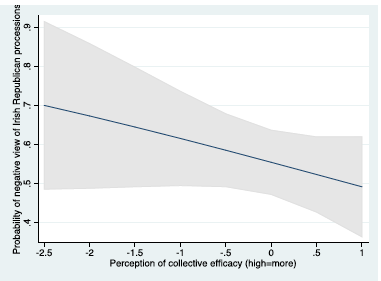
5.13 Similarly, respondents who perceived more racial and ethnic prejudice in Scottish society[73] tended to be more negative about Loyalist processions; however, this association was driven almost entirely by respondents with other or no religion (see Figure AC.4). That is, among respondents who didn't belong to either the Catholic or Protestant groups there was a very strong association between perceptions of racial/ethnic prejudice and negative views of Loyalist processions, but this association was essentially absent among Protestants and Catholics. Respondents who perceived more racial and ethnic prejudice in Scottish society also tended to be more negative about Irish Republican processions; and, again, this association was driven almost entirely by respondents with other or no religion (Figure AC.5).
Figure AC.4: Association between perceptions of racial/ethnic prejudice and negative views of Loyalist processions, by religion
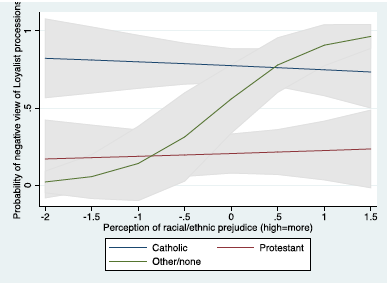
Figure AC.5: Association between perceptions of racial/ethnic prejudice and negative views of Irish Republican processions, by religion
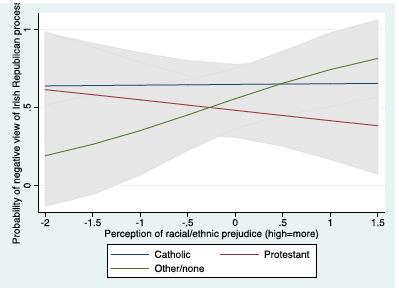
Post-procession residential surveys
Figure AC.6 shows that respondents who perceived there to be more sectarianism in Scottish society tended to be more negative about the Loyalist procession they recalled.[74] However, unlike in the pre-procession survey neither social cohesion nor location were associated with views of the processions. When it came to taking a negative stance toward a recent procession it was someone's religion and perception of sectarianism that was important, not where they lived (and thus the specific procession concerned).
Figure AC.6: Association between views on sectarianism and recent Loyalist procession
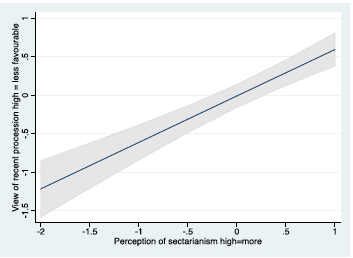
Contact
Email: Linzie Liddell
There is a problem
Thanks for your feedback